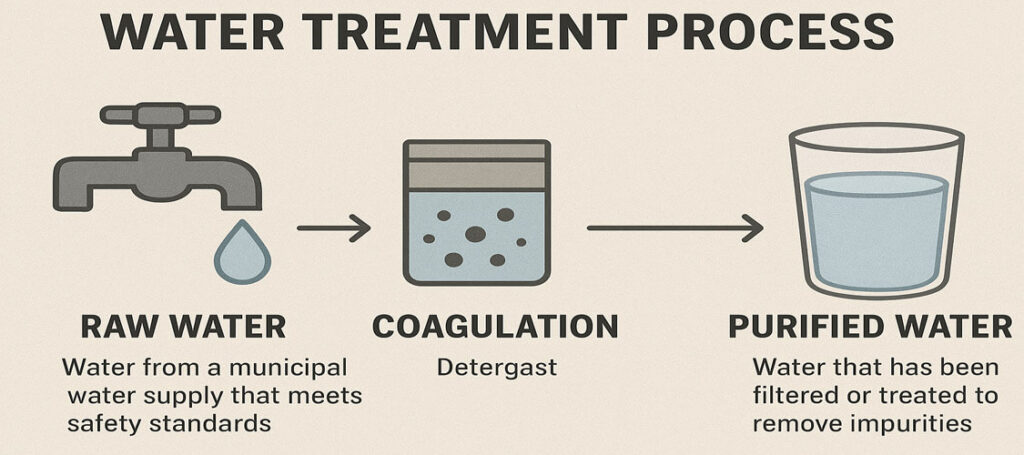When it comes to wet wipes, one important question often arises: What type of water is used in production? Is it safe to use ordinary tap water, or must manufacturers rely on pure water? The answer matters not just for product quality, but also for safety and consumer trust. 🧴👶
1. 🌊 Definitions
- Ordinary Water (Tap Water): Water sourced from municipal supplies. While usually safe for drinking, it may still contain minerals, chlorine, microorganisms, and other impurities that can affect the stability and safety of wet wipes.
- Pure Water (Purified or RO/DI Water): Water that has gone through purification methods such as reverse osmosis (RO), deionization (DI), or distillation. This type of water is free from bacteria, minerals, and chemical residues, making it safe for sensitive use.
2. ⚠️ Why Water Type Matters in Wet Wipes Production
Wet wipes directly touch the skin—often delicate areas like a baby’s face, hands, or mouth. Using the wrong type of water can lead to contamination, spoilage, or skin irritation. That’s why choosing the right water is not optional—it’s a necessity. ✅
- If Ordinary Water Is Used:
- 🚫 Risk of bacterial or fungal contamination.
- ⚡ Minerals may react with ingredients, reducing wipe effectiveness or causing discoloration.
- ⏳ Shorter shelf life.
- If Pure Water Is Used:
- 🛡️ Eliminates harmful microorganisms.
- 📈 Extends product stability and shelf life.
- 💆 Gentle and safe for sensitive skin.
- 🌍 Meets international hygiene and cosmetic safety standards.
3. 🔍 Pros and Cons
| 💦 Water Type | ✅ Pros | ❌ Cons |
|---|---|---|
| Ordinary Water | – Low cost- Easily available | – Risk of contamination- Short shelf life- May irritate skin |
| Pure Water | – Safe and hygienic- Longer shelf life- Gentle on skin | – Higher production cost- Requires advanced filtration equipment |
4. 🌐 Industry Standard
Most reputable wet wipes manufacturers always use pure water. It is the global standard for safety and quality, especially for baby wipes, facial wipes, and medical-grade wipes. 🍼💄🩺 Ordinary water may sometimes be used for industrial cleaning wipes, but it is unsuitable for personal care products where safety is a priority.
5. 📊 Key Takeaways for Consumers & Businesses
- For personal care wipes (baby, facial, medical), pure water is non-negotiable. 🚼
- For industrial wipes, cost may lead to the use of ordinary water, but shelf life and hygiene risks must be managed. 🏭
- Investing in purification equipment ensures both compliance and customer trust. 🤝
6. ❓ Common Misconceptions
- “If tap water is safe to drink, it must be safe for wipes.” 🚱 Drinking water is not the same as manufacturing water. Once sealed inside packaging, tap water can foster microbial growth.
- “Pure water is just marketing hype.” 📢 Not true—pure water significantly reduces contamination risks and extends shelf life.
- “Ordinary water + preservatives = safe wipes.” 🧪 Preservatives help, but they cannot fully prevent bacterial growth in impure water.
7. ⚙️ Water Purification in Wet Wipes Manufacturing
Pure water used in wipes typically undergoes multiple purification stages:

- Pre-filtration – Removes large particles like sand, rust, or dust.
- Activated Carbon Filtration – Eliminates chlorine, odors, and organic matter.
- Reverse Osmosis (RO) – Filters out dissolved salts, minerals, and heavy metals.
- Deionization (DI) – Removes remaining ions and ensures chemical purity.
- UV Sterilization & Ozone Treatment – Destroys bacteria, fungi, and viruses for microbiological safety.
This multi-step process ensures that the water used in wipes is as clean and safe as possible. 🔬✨
